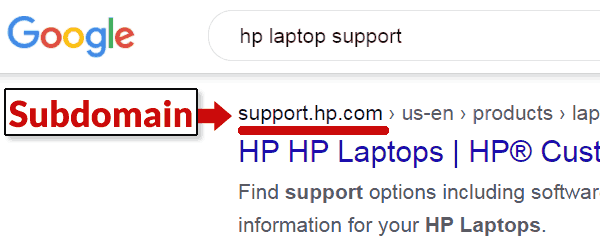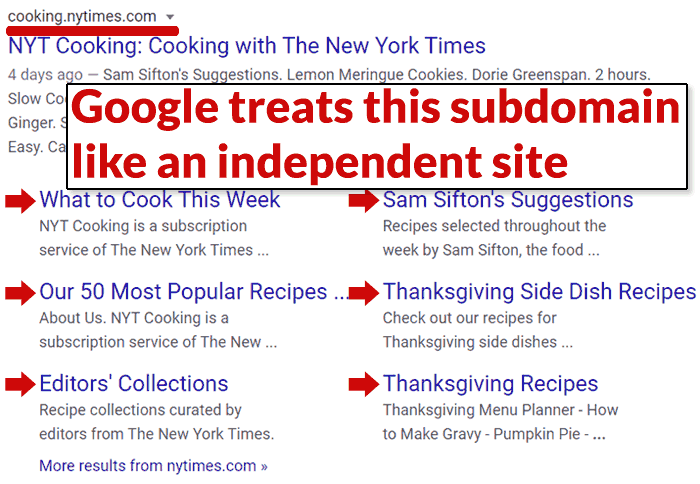SEO
Subdomains vs. Subfolders: Which Is Better for SEO & Why?
Google ranks subdomains more or less the same as subdirectories (also referred to as subfolders).
But there’s a key difference, in that subdomains are considered standalone sites and distinct from the main domain.
It’s important to consider the practical impact on your SEO before choosing to place content on a subdomain or a subdirectory.
The Difference Between a Subdomain & Subdirectory
What Is a Subdirectory?
A website is typically made up of different category sections and web pages.
In the old days of HTML coding, a web designer would create folders and put the web pages into those folders.
That’s why they are called “subfolders“ or “subdirectories.”
This is very similar to how file storage works on a desktop computer, where you create folders and put images or spreadsheet files into the folders.
Just like your desktop folders, the online folders would have a name like /green-widgets/. That’s where all the green widget HTML pages would go.
When you navigated to those pages, you would literally be navigating to a folder and an actual HTML file:
https://www.example.com/widgets/green-widgets/big-green-widget.html
Those folders, /widgets/ and /green-widgets/ are called subdirectories or subfolders.
In typical WordPress and other PHP-based websites, those subdirectories are virtual.
They don’t exist on the server where you can navigate to them with an FTP program and see the actual folders.
Though virtual, they are still a part of the file structure of the website and are still called subdirectories.
A subdirectory is a part of the structure of the website that’s associated with the domain name.
What Is a Subdomain?
A subdomain is very different from a subdirectory; it is like an entirely different website.
The subdomain is associated with the domain, but not the website that is associated with the domain name.
A subdomain is generally considered as a standalone site that is branched off from the main domain.
This is an example of a subdomain:
support.example.com
This is an example of a subdomain that contains a subdirectory:
support.example.com/faq/
Google Considers Subdomains as Separate Standalone Sites
Google has always treated subdomains as different sites, separate from the main domain.
This is evident within Google Search Console, where subdomains have to be verified separately from the content that exists under the main domain website.
Google’s John Mueller explained this in a Webmaster Video:
“You’ll need to verify subdomains separately in Search Console, make any changes to settings and track overall performance per subdomain.
We do have to learn how to crawl them separately but for the most part that’s just a formality for the first few days.”
When to Use a Subdomain
There are technical, branding, and SEO implications as to why a publisher would choose to host content on a subdomain.
Technical Reasons to Use a Subdomain
A web developer may choose to host a staging version of a website on a password protected subdomain (a staging site is a copy of a site created by the developer in order to test a new web design template).
It’s easy to set up a new database and install a new version of a site in that subdomain that exactly replicates the production site (the version of the site that visitors visit).
As long as the subdomain is not linked from anywhere on the web, search engine crawlers will generally not find that subdomain. If they do, they won’t be able to crawl the staging site because it is password protected.
On a technical level, the staging site hosted on a subdomain can have the same directory, URL, and permalink structure as the main site that is live on the web.
Hosting a staging site on a subdirectory is trickier and errors in link structure can creep in.
For technical reasons, developers may find it easier to create a new database for a subdomain and treat that section like an independent website, keeping all database and CMS files completely separate from the rest of the main site.
Splitting out a site on a subdomain allows the developer to easily use 100% different layout templates and technologies without affecting the main site.
Branding Reasons to Use a Subdomain
Branding is another reason to use a subdomain.
For example, publishers often choose to host their support sections on a subdomain.
There, a user can find downloadable documentation, FAQs, and Q&A forums under a subdomain like support.example.com
 Screenshot of a Subdomain Used to Brand a Support Section
Screenshot of a Subdomain Used to Brand a Support SectionFor branding purposes, some businesses may elect to create a separate subdomain to compartmentalize and brand a section of their site such as the support pages and keep them away from the rest of the main site.
SEO Reasons to Use Subdomains
There may also be SEO reasons for hosting on a subdomain; for example, if a publisher has a content topic that is completely different from that main site.
The publisher can choose to host that section on a subdomain in order to isolate that content within its own website but still be within the brand of the main site.
Some news sites host their recipe content on a subdomain, for example.
I don’t know if that’s done for SEO reasons but it’s an example of how to separate one section of a site that has a vastly different topic from the rest of the site, where one section is static and relatively evergreen and the rest of the site is in a constant state of change.
 Screenshot of a News Site Hosting Recipe Content on a Subdomain
Screenshot of a News Site Hosting Recipe Content on a SubdomainBy separating the recipe section from the rest of the site, a publisher can control what that entire section is about (recipes) and not allow the rest of the site to influence or overwhelm that one section.
Whether Google can rank a subdomain section better if it’s isolated is a matter of opinion.
But this is something that is done for SEO reasons, to allow a subdomain to rank on its own without influence from the main site and vice-versa.
Below is the SERP display for The New York Times’ recipe subdomain section.
When you search for “recipes NYTimes” Google displays it in the SERPs like a standalone website, complete with a six-pack listing of subsections.
 Screenshot of The New York Times Cooking Subdomain in Google’s SERPs
Screenshot of The New York Times Cooking Subdomain in Google’s SERPsSubdirectory Layouts Are Useful
A site that is comprehensive can be seen as more authoritative than a site that only focuses on a granular part of a topic.
That doesn’t mean that the granular site less authoritative or useful.
But a site that can encompass the full breadth and depth of the topic can attract more links and be recognized as authoritative.
For that reason, a site might choose to use subfolders over a subdomain approach.
Another reason to use a subdirectory layout is that there is overlap between different sections.
Someone shopping online for cereal may want to pick up a pair of gym pants to use while working from home.
A site that carries both items is more useful than a site that only focuses on one or the other.
Subdirectory or Subdomain? Choose What Works Best
The most important consideration for whether to use a subdomain is if it works for users.
Even so, the SEO, branding, and technical advantages of each need to be considered.
In general, if it makes sense for users that a section belongs with the rest of the site, then using a subdirectory structure is the best way to structure a website.
But if the section is better as a standalone site because it is so different from the rest of the site and you want it to keep associating that section with the branding or name of the main site, then a subdomain might be the better approach for you.
Sometimes, there just isn’t a definitive answer as to which way is best. But by taking all these factors into consideration, the choice becomes easier to make.
Image Credits:
All screenshots taken by author, December 2020
SEO
Google Declares It The “Gemini Era” As Revenue Grows 15%

Alphabet Inc., Google’s parent company, announced its first quarter 2024 financial results today.
While Google reported double-digit growth in key revenue areas, the focus was on its AI developments, dubbed the “Gemini era” by CEO Sundar Pichai.
The Numbers: 15% Revenue Growth, Operating Margins Expand
Alphabet reported Q1 revenues of $80.5 billion, a 15% increase year-over-year, exceeding Wall Street’s projections.
Net income was $23.7 billion, with diluted earnings per share of $1.89. Operating margins expanded to 32%, up from 25% in the prior year.
Ruth Porat, Alphabet’s President and CFO, stated:
“Our strong financial results reflect revenue strength across the company and ongoing efforts to durably reengineer our cost base.”
Google’s core advertising units, such as Search and YouTube, drove growth. Google advertising revenues hit $61.7 billion for the quarter.
The Cloud division also maintained momentum, with revenues of $9.6 billion, up 28% year-over-year.
Pichai highlighted that YouTube and Cloud are expected to exit 2024 at a combined $100 billion annual revenue run rate.
Generative AI Integration in Search
Google experimented with AI-powered features in Search Labs before recently introducing AI overviews into the main search results page.
Regarding the gradual rollout, Pichai states:
“We are being measured in how we do this, focusing on areas where gen AI can improve the Search experience, while also prioritizing traffic to websites and merchants.”
Pichai reports that Google’s generative AI features have answered over a billion queries already:
“We’ve already served billions of queries with our generative AI features. It’s enabling people to access new information, to ask questions in new ways, and to ask more complex questions.”
Google reports increased Search usage and user satisfaction among those interacting with the new AI overview results.
The company also highlighted its “Circle to Search” feature on Android, which allows users to circle objects on their screen or in videos to get instant AI-powered answers via Google Lens.
Reorganizing For The “Gemini Era”
As part of the AI roadmap, Alphabet is consolidating all teams building AI models under the Google DeepMind umbrella.
Pichai revealed that, through hardware and software improvements, the company has reduced machine costs associated with its generative AI search results by 80% over the past year.
He states:
“Our data centers are some of the most high-performing, secure, reliable and efficient in the world. We’ve developed new AI models and algorithms that are more than one hundred times more efficient than they were 18 months ago.
How Will Google Make Money With AI?
Alphabet sees opportunities to monetize AI through its advertising products, Cloud offerings, and subscription services.
Google is integrating Gemini into ad products like Performance Max. The company’s Cloud division is bringing “the best of Google AI” to enterprise customers worldwide.
Google One, the company’s subscription service, surpassed 100 million paid subscribers in Q1 and introduced a new premium plan featuring advanced generative AI capabilities powered by Gemini models.
Future Outlook
Pichai outlined six key advantages positioning Alphabet to lead the “next wave of AI innovation”:
- Research leadership in AI breakthroughs like the multimodal Gemini model
- Robust AI infrastructure and custom TPU chips
- Integrating generative AI into Search to enhance the user experience
- A global product footprint reaching billions
- Streamlined teams and improved execution velocity
- Multiple revenue streams to monetize AI through advertising and cloud
With upcoming events like Google I/O and Google Marketing Live, the company is expected to share further updates on its AI initiatives and product roadmap.
Featured Image: Sergei Elagin/Shutterstock
SEO
brightonSEO Live Blog

Hello everyone. It’s April again, so I’m back in Brighton for another two days of Being the introvert I am, my idea of fun isn’t hanging around our booth all day explaining we’ve run out of t-shirts (seriously, you need to be fast if you want swag!). So I decided to do something useful and live-blog the event instead.
Follow below for talk takeaways and (very) mildly humorous commentary. sun, sea, and SEO!
SEO
Google Further Postpones Third-Party Cookie Deprecation In Chrome

Google has again delayed its plan to phase out third-party cookies in the Chrome web browser. The latest postponement comes after ongoing challenges in reconciling feedback from industry stakeholders and regulators.
The announcement was made in Google and the UK’s Competition and Markets Authority (CMA) joint quarterly report on the Privacy Sandbox initiative, scheduled for release on April 26.
Chrome’s Third-Party Cookie Phaseout Pushed To 2025
Google states it “will not complete third-party cookie deprecation during the second half of Q4” this year as planned.
Instead, the tech giant aims to begin deprecating third-party cookies in Chrome “starting early next year,” assuming an agreement can be reached with the CMA and the UK’s Information Commissioner’s Office (ICO).
The statement reads:
“We recognize that there are ongoing challenges related to reconciling divergent feedback from the industry, regulators and developers, and will continue to engage closely with the entire ecosystem. It’s also critical that the CMA has sufficient time to review all evidence, including results from industry tests, which the CMA has asked market participants to provide by the end of June.”
Continued Engagement With Regulators
Google reiterated its commitment to “engaging closely with the CMA and ICO” throughout the process and hopes to conclude discussions this year.
This marks the third delay to Google’s plan to deprecate third-party cookies, initially aiming for a Q3 2023 phaseout before pushing it back to late 2024.
The postponements reflect the challenges in transitioning away from cross-site user tracking while balancing privacy and advertiser interests.
Transition Period & Impact
In January, Chrome began restricting third-party cookie access for 1% of users globally. This percentage was expected to gradually increase until 100% of users were covered by Q3 2024.
However, the latest delay gives websites and services more time to migrate away from third-party cookie dependencies through Google’s limited “deprecation trials” program.
The trials offer temporary cookie access extensions until December 27, 2024, for non-advertising use cases that can demonstrate direct user impact and functional breakage.
While easing the transition, the trials have strict eligibility rules. Advertising-related services are ineligible, and origins matching known ad-related domains are rejected.
Google states the program aims to address functional issues rather than relieve general data collection inconveniences.
Publisher & Advertiser Implications
The repeated delays highlight the potential disruption for digital publishers and advertisers relying on third-party cookie tracking.
Industry groups have raised concerns that restricting cross-site tracking could push websites toward more opaque privacy-invasive practices.
However, privacy advocates view the phaseout as crucial in preventing covert user profiling across the web.
With the latest postponement, all parties have more time to prepare for the eventual loss of third-party cookies and adopt Google’s proposed Privacy Sandbox APIs as replacements.
Featured Image: Novikov Aleksey/Shutterstock
-

 PPC7 days ago
PPC7 days ago19 Best SEO Tools in 2024 (For Every Use Case)
-
SEARCHENGINES6 days ago
Daily Search Forum Recap: April 19, 2024
-

 WORDPRESS7 days ago
WORDPRESS7 days agoHow to Make $5000 of Passive Income Every Month in WordPress
-

 MARKETING6 days ago
MARKETING6 days agoBattling for Attention in the 2024 Election Year Media Frenzy
-

 WORDPRESS5 days ago
WORDPRESS5 days ago13 Best HubSpot Alternatives for 2024 (Free + Paid)
-

 SEO7 days ago
SEO7 days ago25 WordPress Alternatives Best For SEO
-

 WORDPRESS6 days ago
WORDPRESS6 days ago7 Best WooCommerce Points and Rewards Plugins (Free & Paid)
-

 MARKETING7 days ago
MARKETING7 days agoTinuiti Marketing Analytics Recognized by Forrester















